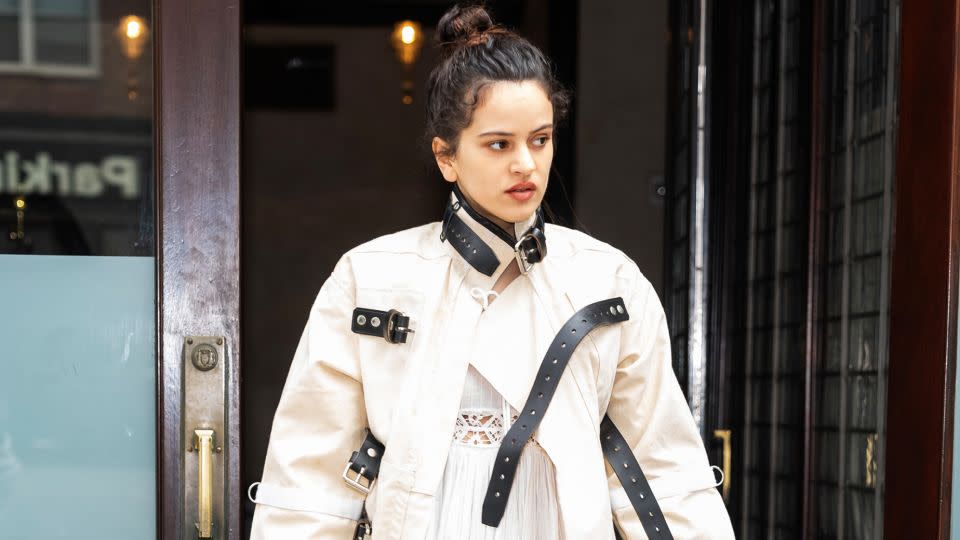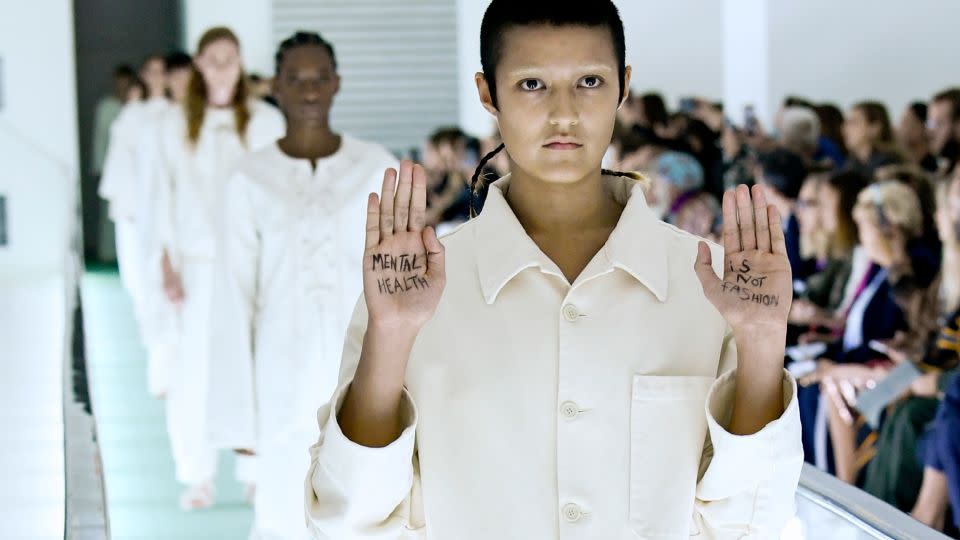Look of the Week: Musician Rosalía brings the straitjacket back into view
- Oops!Something went wrong.Please try again later.
Editor’s Note: Featuring the good, the bad and the ugly, ‘Look of the Week’ is a regular series dedicated to unpacking the most talked about outfit of the last seven days.
On Tuesday, 12-time Latin Grammy winner Rosalía stepped out in New York wearing an outfit that demanded a double-take. The Spanish pop star wore a dainty white lace prairie dress and a pair of heel-less Rick Owens Cantilever boots, but the main event was shrugged over her shoulders.
Her cream-colored canvas coat was punctuated by a series of black buckles and belts. Was it another vintage biker jacket? (Since the release of her third album, “Motomami,” Rosalía has been spotted in everything from biker-style shield sunglasses to Harley Davidson helmets). But upon further inspection her outerwear looked more medical than motorcycle. The elongated sleeves sewn shut and finished with another fastening buckle meant the singer’s hands were forced to burst through a side seam. Her coat resembled a straitjacket.
First invented in the 18th-century, straitjackets were used as restraints in hospitals and asylums. Although they were intended to protect patients from harm, some practitioners regarded the physical binding inhumane, with many campaigning for an alternative treatment. By the counter-cultural movement of the 1960s, a wave of anti-psychiatry thinking broke out — criticizing not only practices such as restraint jackets and electroconvulsive therapy (ECT), but mainstream medicine’s definition of mental illness altogether. Straitjackets and their misuse quickly became a cultural symbol of medical barbarism, in part due to films such as “One Flew Over the Cuckoo’s Nest” (1975). In 1994, the New York State’s Office of Mental Health proposed that straitjackets be discontinued after 18 patients died while restrained or in “unsupervised seclusion” between 1988 and 1992.

While they are rarely used in modern establishments today, the image of a restraint jacket can still be a potent reminder of bygone asylums and mistreatment. But Rosalía isn’t the first to attempt to recontextualize the garment in the name of fashion.
In 2019, Gucci sent a series of straitjacket-inspired jumpsuits down the runway at Milan Fashion Week. In a white warehouse, 20 models stood still on a green conveyor belt — each bound by an all-white ensemble, many of which featured buckles and straps. One model in the line-up, Ayesha Tan-Jones, used the runway to stage a silent protest of the looks — writing on their hands “Mental health is not fashion.”
On Instagram, Tan-Jones wrote after the show: “Straitjackets are a symbol of a cruel time in medicine when mental illness was not understood, and people’s rights and liberties were taken away from them, while they were abused and tortured in the institution.”
“Many of the other Gucci models who were in the show felt just as strongly as I did about this depiction of straitjackets, and without their support I would not have had the courage to walk out (on the runway) and peacefully protest,” they said.

The straitjackets only made up half of Gucci’s collection, as the conveyor belt-turned-catwalk was suddenly flooded with colorful clothes more typical of then creative director Alessandro Michele’s style. The brand responded to criticism stating that the “blank-styled clothes represented how through fashion, power is exercised over life, to eliminate self-expression. This power prescribes social norms, classifying and curbing identity.” The luxury fashion house also clarified that the straitjacket-style jumpsuits would not be for sale.
In contrast, Rosalía’s outfit has barely raised an eyebrow. The musician has built a reputation as a sartorial risk-taker, often mixing flamenco influences with on-trend biker chic. And while her outfit has made headlines, it hasn’t caused a debate, perhaps due to the increasing prevalence of shocking ensembles out there. Since the rise of Julia Fox in 2021, we’ve seen dresses made from coat hangers, garbage bags and saran wrap. Last September, Ye’s wife Bianca Censori was pictured in Florence, Italy wearing nothing but a purple pillowcase.
Fashion houses previously at the center of public criticism have also risen from the ashes. John Galliano —convicted of hate crimes and fired from Dior in 2011 — has been reputationally resurrected with a landmark show at Maison Margiela and the release of a new documentary. Similarly, Dolce & Gabbana have rebuilt an impressive celebrity roster after a series of promotional videos advertising their Shanghai show were accused of being racist in 2018. (The brand later released an official press statement that said the event and videos were “created especially with love and passion for China and all the people around the world who loves Dolce & Gabbana.”)
Is Rosalia making a social statement with her straitjacket-style outerwear, or merely using what was once considered shocking for a street style snap? What is certain is that, in 2024, fashion is a lot more comfortable blurring those boundaries.
For more CNN news and newsletters create an account at CNN.com

